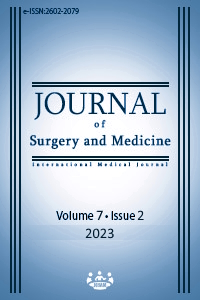Evaluation of vestibular evoked myogenic potential values in elder patients with hip fractures: A prospective controlled study
Vestibular evoked myogenic potentials in patients with hip fractures
Keywords:
cVEMP, hip fracture, balance disorder, vestibular dysfunctionAbstract
Background/Aim: Hip fractures among the elderly are a major public health problem that cause high rates of morbidity and mortality. There are many studies regarding prevention and defining the underlying causes of hip fractures. The purpose of this study was to evaluate the cervical vestibular evoked myogenic potential (cVEMP) test responses of elderly patients without vestibular symptoms hospitalized due to fall-related hip fractures in order to evaluate the subclinical vestibular dysfunction rates in patients with hip fractures.
Methods: Twenty-two patients aged 67-79 hospitalized due to fall-related hip fractures and 24 control patients presenting to the orthopedic clinic due to knee pain were included in the study. The participants underwent detailed otological examination and cVEMP tests. The two groups’ cVEMP records were then compared.
Results: The demographic characteristics of the participants in the patient and control groups including age, gender, and race were similar. There was no statistically significant difference between the groups’ absent VEMP response rates. No significant difference in terms of P1 and N1 latencies was determined between the right and left ears in either group. The hip fracture group (study group) had significantly increased P1 and N1 latencies in cVEMP which is associated with central vestibular dysfunction. (P=0.008 and P=0.007, respectively).
Conclusion: The rate of subclinical peripheral vestibular dysfunction, which can be identified by cVEMP evaluation, is increased in elderly patients with hip fractures caused by low energy trauma. Precautions like vestibular rehabilitation can be a preventive measure for hip fractures in the elderly.
Downloads
References
Sterling RS. Gender and race/ethnicity differences in hip fracture incidence, morbidity, mortality, and function. Clin Orthop Relat Res. 2011 Jul;469(7):1913-8. doi: 10.1007/s11999-010-1736-3. PMID: 21161737; PMCID: PMC3111795. DOI: https://doi.org/10.1007/s11999-010-1736-3
Ensrud KE. Epidemiology of fracture risk with advancing age. J Gerontol A Biol Sci Med Sci. 2013 Oct;68(10):1236-42. doi: 10.1093/gerona/glt092. Epub 2013 Jul 5. PMID: 23833201. DOI: https://doi.org/10.1093/gerona/glt092
Veronese N, Maggi S. Epidemiology and social costs of hip fracture. Injury. 2018 Aug;49(8):1458-60. doi: 10.1016/j.injury.2018.04.015. Epub 2018 Apr 20. PMID: 29699731. DOI: https://doi.org/10.1016/j.injury.2018.04.015
Neto JS, Dias CR, de Almeida JD. Epidemiological characteristics and causes of proximal femoral fractures among the elderly. Rev Bras Ortop. 2015 Nov 16;46(6):660-7. doi: 10.1016/S2255-4971(15)30322-0. PMID: 27027070; PMCID: PMC4799322. DOI: https://doi.org/10.1016/S2255-4971(15)30322-0
Nevitt MC, Cummings SR, Hudes ES. Risk factors for injurious falls: a prospective study. J Gerontol. 1991 Sep;46(5):M164-70. doi: 10.1093/geronj/46.5.m164. PMID: 1890282. DOI: https://doi.org/10.1093/geronj/46.5.M164
Chen X, Yang W, Wang X. Balance training can enhance hip fracture patients' independence in activities of daily living: A meta-analysis of randomized controlled trials. Medicine (Baltimore). 2020 Apr;99(16):e19641. doi: 10.1097/MD.0000000000019641. PMID: 32311935; PMCID: PMC7440254. DOI: https://doi.org/10.1097/MD.0000000000019641
Değer TB, Saraç ZF, Savaş ES, Akçiçek SF. The Relationship of Balance Disorders with Falling, the Effect of Health Problems, and Social Life on Postural Balance in the Elderly Living in a District in Turkey. Geriatrics (Basel). 2019 May 17;4(2):37. doi: 10.3390/geriatrics4020037. PMID: 31108836; PMCID: PMC6630729. DOI: https://doi.org/10.3390/geriatrics4020037
Ohara A, Yasuhiro M, Mochizuki F, Shinohe T, Sasano Y, Suzuki K, Mikami K, Koizuka I. Effects of using cane and vestibular rehabilitation on the walking function in elderly patients with dizziness. Auris Nasus Larynx. 2021 Aug;48(4):571-6. doi: 10.1016/j.anl.2020.10.010. Epub 2020 Nov 19. PMID: 33223340. DOI: https://doi.org/10.1016/j.anl.2020.10.010
Shumway-Cook A, Ciol MA, Gruber W, Robinson C. Incidence of and risk factors for falls following hip fracture in community-dwelling older adults. Phys Ther. 2005 Jul;85(7):648-55. PMID: 15982171. DOI: https://doi.org/10.1093/ptj/85.7.648
Halvarsson A, Dohrn IM, Ståhle A. Taking balance training for older adults one step further: the rationale for and a description of a proven balance training programme. Clin Rehabil. 2015 May;29(5):417-25. doi: 10.1177/0269215514546770. Epub 2014 Sep 8. PMID: 25200877; PMCID: PMC4419050. DOI: https://doi.org/10.1177/0269215514546770
Rosengren SM, Colebatch JG, Young AS, Govender S, Welgampola MS. Vestibular evoked myogenic potentials in practice: Methods, pitfalls and clinical applications. Clin Neurophysiol Pract. 2019 Feb 26;4:47-68. doi: 10.1016/j.cnp.2019.01.005. PMID: 30949613; PMCID: PMC6430081. DOI: https://doi.org/10.1016/j.cnp.2019.01.005
Wu HJ, Shiao AS, Yang YL, Lee GS. Comparison of short tone burst-evoked and click-evoked vestibular myogenic potentials in healthy individuals. J Chin Med Assoc. 2007 Apr;70(4):159-63. doi: 10.1016/S1726-4901(09)70350-8. Erratum in: J Chin Med Assoc. 2008 Apr;71(4):221. PMID: 17475597. DOI: https://doi.org/10.1016/S1726-4901(09)70350-8
Fife TD, Colebatch JG, Kerber KA, Brantberg K, Strupp M, Lee H, et al. Practice guideline: Cervical and ocular vestibular evoked myogenic potential testing: Report of the Guideline Development, Dissemination, and Implementation Subcommittee of the American Academy of Neurology. Neurology. 2017 Nov 28;89(22):2288-96. doi: 10.1212/WNL.0000000000004690. Epub 2017 Nov 1. PMID: 29093067; PMCID: PMC5705249. DOI: https://doi.org/10.1212/WNL.0000000000004690
Zuniga MG, Dinkes RE, Davalos-Bichara M, Carey JP, Schubert MC, King WM, Walston J, Agrawal Y. Association between hearing loss and saccular dysfunction in older individuals. Otol Neurotol. 2012 Dec;33(9):1586-92. doi: 10.1097/MAO.0b013e31826bedbc. PMID: 23064383; PMCID: PMC3498596. DOI: https://doi.org/10.1097/MAO.0b013e31826bedbc
Negishi-Oshino R, Ohgami N, He T, Ohgami K, Li X, Kato M. cVEMP correlated with imbalance in a mouse model of vestibular disorder. Environ Health Prev Med. 2019 Jun 1;24(1):39. doi: 10.1186/s12199-019-0794-8. PMID: 31153359; PMCID: PMC6545207. DOI: https://doi.org/10.1186/s12199-019-0794-8
Murofushi T, Halmagyi GM, Yavor RA, Colebatch JG. Absent vestibular evoked myogenic potentials in vestibular neurolabyrinthitis. An indicator of inferior vestibular nerve involvement? Arch Otolaryngol Head Neck Surg. 1996 Aug;122(8):845-8. doi: 10.1001/archotol.1996.01890200035008. PMID: 8703387. DOI: https://doi.org/10.1001/archotol.1996.01890200035008
Piker EG, Jacobson GP, Burkard RF, McCaslin DL, Hood LJ. Effects of age on the tuning of the cVEMP and oVEMP. Ear Hear. 2013 Nov-Dec;34(6):e65-73. doi: 10.1097/AUD.0b013e31828fc9f2. PMID: 23673615; PMCID: PMC3748259. DOI: https://doi.org/10.1097/AUD.0b013e31828fc9f2
Gargeshwari A, Jha RH, Singh NK, Kumar P. Behavioural and objective vestibular assessment in persons with osteoporosis and osteopenia: a preliminary investigation. Braz J Otorhinolaryngol. 2018 Nov-Dec;84(6):744-53. doi: 10.1016/j.bjorl.2017.08.013. Epub 2017 Sep 21. PMID: 29030130; PMCID: PMC9442882. DOI: https://doi.org/10.1016/j.bjorl.2017.08.013
Downloads
- 383 560
Published
Issue
Section
How to Cite
License
Copyright (c) 2023 Kübra Topal , Fatih Uğur , Murat Topal , Fatma Atalay , Emel Uğur
This work is licensed under a Creative Commons Attribution-NonCommercial-NoDerivatives 4.0 International License.
















